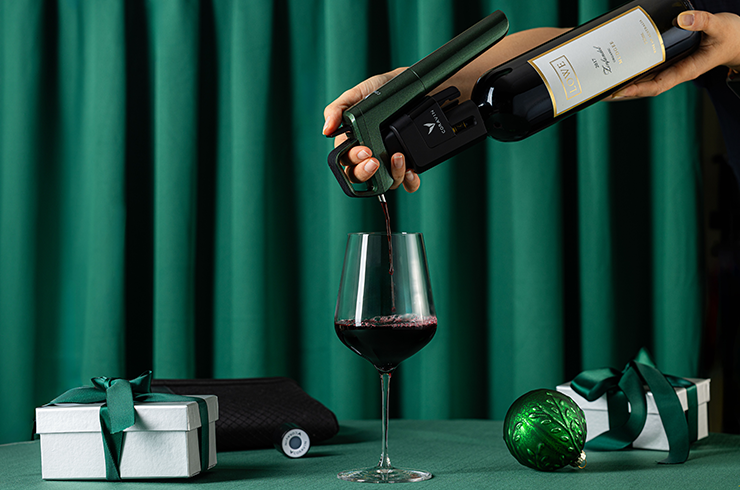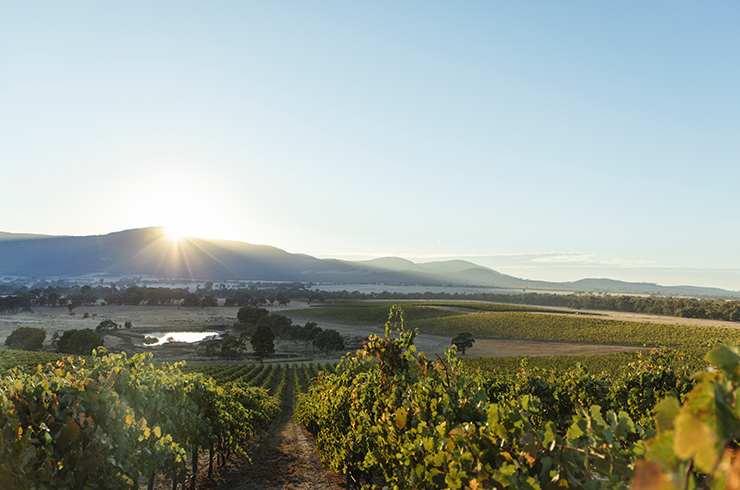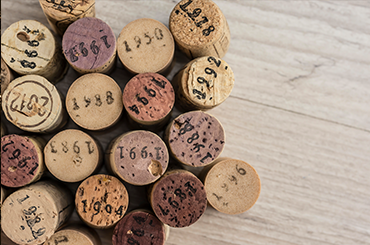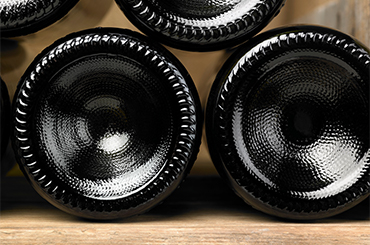Wine storage and cellaring; the essentials of wine storage remain the same, though the sweeping impact of the screwcap must now be considered. James Halliday guides us through the ins and outs.
There are several reasons for this mass migration from corks to screwcaps by Australia's winemakers. Cork taint – usually by a substance in the cork called trichloranisole, or TCA for short – is the less important reason. While the mouldy smell and taste this taint imparts can make the wine undrinkable, Portuguese cork makers have belatedly changed the way wine corks are made, and reportedly reduced the incidence of cork taint to below three per cent – from a much higher level in the 1990s.
If the wine is in its original cardboard box, don’t open it until the time has arrived for consumption unless you clingwrap the labels. Here, simply replace the bottles in the box after applying the clingwrap. Loose bottles should be wrapped in newspaper (a sticker showing the name of each wine on the newspaper) and packed tightly in the carton, the contents noted on the outside, each carton with a number.
It’s sensible to keep at least one bottle of each wine accessible so you can check the progress of the wine. These are best stored in racks, allowing single bottle access. Moreover, bottles with corks must be cellared on their side; those with screwcaps can be stored in whichever way (standing up or lying down) suits you best.
To keep an exact record of the wines in your cellar, go to the HALLIDAY VIRTUAL CELLAR
Some corks will withstand the hydraulic pressure increases when the wine warms and some will eventually succumb, allowing air (oxygen) into the bottle and the escape of remnant sulphur dioxide. Thus, two bottles stored next to each other from day one may perform very differently, giving rise to what is called sporadic (random) oxidation.
The ultimate vote of confidence in the screwcap. In all seriousness, I have offered to pay an extra $100 per bottle to Domaine de la Romanee-Conti for the wines I buy from it each year to be sealed with a screwcap, rather than the cork they steadfastly use. Aubert de Villaine (the proprietor of the Domaine) knows I am sincere, but of course, is not the least bit tempted to make such a radical move.
How should I store wine?
The elephant in the wine cellar is the screwcap. Of the 6827 wines detailed in my 2012 Wine Companion, 85 per cent used screwcaps, while tellingly, only eight per cent used one-piece natural corks (the remainder using various other closures). Even this tells only part of the story: 96.8 per cent of white table wines were screwcapped and less than one per cent used cork. Clearly, in terms of wine storage advice in Australia, it is a whole new landscape.There are several reasons for this mass migration from corks to screwcaps by Australia's winemakers. Cork taint – usually by a substance in the cork called trichloranisole, or TCA for short – is the less important reason. While the mouldy smell and taste this taint imparts can make the wine undrinkable, Portuguese cork makers have belatedly changed the way wine corks are made, and reportedly reduced the incidence of cork taint to below three per cent – from a much higher level in the 1990s.
Daily temperature changes
But the most important failure of cork is oxidation; that is, where the cork simply hasn’t done its job of keeping the air out. This is where storage/cellar conditions become critical. In turn, variations in cellar temperatures are the oft-hidden source of all evil for wines sealed by corks. The most critical temperature changes are those recorded daily, although these will be coupled with seasonal changes. The reason that temperature changes are so damaging stems from the expansion of the wine as the temperature rises, and contraction as it falls. A digital thermometer in your cellar tracking daily and seasonal highs and lows is essential, even if it is the bearer of bad news.Wine storage temperature
So, ideal cellar conditions are a temperature of up to 15˚C, a relative humidity of 75 per cent, and that these conditions suffer as little variation as possible. You don’t want your wine expanding and contracting daily. A refrigerated cellar (that maintains humidity) can achieve these parameters, but for many this is not possible (other than units such as Vintech, the drawbacks being limited space and expense). Just be prepared: wine collections tend to mysteriously increase in size. Single bottle storage in racks (and DIY racks using concrete reinforcing steel mesh are every bit as good as the more expensive purpose-built versions) is preferable, especially if you’ve gone to the expense of building a full climate-controlled cellar.How to store wine in the home?
Then there’s the issue of storage somewhere in the home, with no access to climate or humidity control. If humidity is too high (usual with under-house storage or in the tropics), wrap the bottles in cling film, and the labels will be perfectly preserved. This method is also the one protection against the ultimate disaster – flood.If the wine is in its original cardboard box, don’t open it until the time has arrived for consumption unless you clingwrap the labels. Here, simply replace the bottles in the box after applying the clingwrap. Loose bottles should be wrapped in newspaper (a sticker showing the name of each wine on the newspaper) and packed tightly in the carton, the contents noted on the outside, each carton with a number.
What is the best temperature to store red wine?
The ideal temperature to store red wine is between 12-14 degrees celsius and it is important to try to keep the storage temperature of a wine as consistent as possible. If you don't have a cool, dark spot in your home that will provide these conditions, consider investing in a wine fridge to ensure the seal of your bottles doesn't become compromised.
What will I drink… next winter?
Try to look ahead as far as possible – place the cartons and boxes of wine you don’t intend to soon drink on the bottom of the stack, and pack the boxes tightly on each other, so arranged that you can either see the box number or have a record of its position. Packed this way, the stack creates its own thermal stability, and temperature change will be minimised.It’s sensible to keep at least one bottle of each wine accessible so you can check the progress of the wine. These are best stored in racks, allowing single bottle access. Moreover, bottles with corks must be cellared on their side; those with screwcaps can be stored in whichever way (standing up or lying down) suits you best.
To keep an exact record of the wines in your cellar, go to the HALLIDAY VIRTUAL CELLAR
No great cork-sealed wines, just great bottles…
No two corks are exactly the same, nor are the interiors of the bottles’ necks. Cork manufacturers are forever saying cork is a “natural thing” and indeed it is – hence the variation in what is a truly amazing substance, with 40 million gas-filled hexagonal cells per cubic centimetre.Some corks will withstand the hydraulic pressure increases when the wine warms and some will eventually succumb, allowing air (oxygen) into the bottle and the escape of remnant sulphur dioxide. Thus, two bottles stored next to each other from day one may perform very differently, giving rise to what is called sporadic (random) oxidation.
The colour factor
Colour is a good indication of how a wine has been stored – or how the cork has performed. White wines such as semillon and riesling (closed with corks) are especially sensitive, and the colour change in as little as two years may start to be obvious even before the wine is poured from the bottle. The deeper and more yellow or brown the colour, the more obvious the development of flavour (or more obvious the storage/cork issue). Depending on overall cellar conditions (and overall cork quality) a volume of the wine itself will slowly be lost as the wine expands and contracts, and a substantial air space (called ullage) will start to develop. This loss of wine volume is sometimes referred to as the “angel’s share”.Screwcaps
Screwcaps prevent or slow the more obvious changes in wine as it ages: colour development in all the bottles stored alongside each other will be identical, and the fill levels will remain as they were on day one. But if the cellar has warm periods (daily or seasonally) the wine will develop more rapidly. Most of the changes a wine goes through over time are anaerobic (they don’t depend on a constant supply of oxygen, a substance that Louis Pasteur succinctly described as “the enemy of wine”), which means that screwcaps are a great seal for wine to be aged under.The ultimate vote of confidence in the screwcap. In all seriousness, I have offered to pay an extra $100 per bottle to Domaine de la Romanee-Conti for the wines I buy from it each year to be sealed with a screwcap, rather than the cork they steadfastly use. Aubert de Villaine (the proprietor of the Domaine) knows I am sincere, but of course, is not the least bit tempted to make such a radical move.







